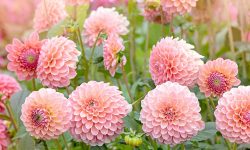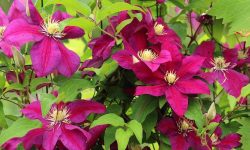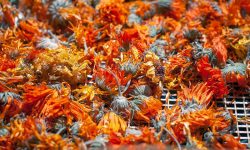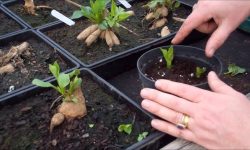Anthuriums, also known as flamingo flowers or laceleaf, are tropical houseplants that bring a splash of color and elegance to any indoor space. With their shiny, heart-shaped leaves and vibrant, waxy flowers in red, pink, white, or purple, they have become a favorite for indoor gardening enthusiasts across the globe.
Caring for anthurium plants requires an understanding of their tropical roots, which means creating the right balance of warmth, humidity, and indirect sunlight. If you want to keep your flamingo flower thriving year-round, this comprehensive guide will walk you through everything you need to know—from watering and light to fertilizing and propagation.
Understanding the Anthurium Plant

Origin and Characteristics
Anthuriums are native to the rainforests of Central and South America. As epiphytes in the wild, they often grow on trees and absorb moisture and nutrients from the air and debris around them. This background influences how they grow indoors—requiring well-aerated soil, high humidity, and minimal direct sunlight.
The plant’s most distinctive feature is its flower, which is technically a spathe and spadix. The spathe is the colorful, petal-like structure, while the spadix is the central spike that contains tiny flowers. These blooms can last several weeks or even months under ideal conditions.
Varieties of Anthurium
While the red-flowered Anthurium andraeanum is the most popular type for indoor growing, there are over 1,000 species and cultivars. Some are grown for their flowers, while others are prized for their stunning foliage, like Anthurium clarinervium or Anthurium crystallinum, which have velvety, deeply veined leaves.
Creating the Ideal Environment
Light Requirements
Anthuriums thrive in bright, indirect light. Too much direct sunlight can scorch their leaves, while too little light results in slow growth and fewer blooms. A north- or east-facing window is usually perfect. If you’re growing anthurium in a room with limited natural light, consider using a grow light to supplement.
The plant will give you signs when it isn’t receiving the right light. Yellowing leaves or faded flowers often indicate excessive light, while leggy growth and lack of flowering suggest insufficient light.
Temperature and Humidity
As tropical plants, anthuriums prefer warm, humid environments. The ideal temperature range is between 65°F to 80°F (18°C to 27°C). They should never be exposed to temperatures below 55°F (13°C), as this can stress the plant or lead to dormancy.
Humidity plays a crucial role in their well-being. These plants need at least 60% humidity to flourish. In dry climates or during winter, consider placing a humidifier nearby, grouping plants together, or placing the pot on a tray filled with water and pebbles to boost moisture levels in the air.
Potting and Soil Considerations
Choosing the Right Pot
Anthuriums do best in pots with excellent drainage. Choose a container with drainage holes to avoid water accumulation at the bottom, which can cause root rot. A plastic or glazed ceramic pot works well because it retains moisture better than terracotta.
Repotting is recommended every 1 to 2 years, usually in spring. This allows the roots to expand and prevents the soil from compacting. When repotting, gently shake off old soil and trim away any dead or mushy roots before transferring the plant to fresh soil.
Soil Composition
Since anthuriums are epiphytes, they need soil that mimics their native growing conditions. A mixture of orchid bark, peat moss or coco coir, and perlite is ideal. The soil should be light, well-aerated, and slightly acidic, with a pH between 5.5 and 6.5.
Avoid using regular potting soil alone, as it retains too much moisture and restricts air flow, both of which can harm your anthurium.
Watering Practices
How Often to Water
Anthuriums prefer their soil to remain lightly moist, not soggy. Overwatering is a common mistake and can lead to root rot, while underwatering causes dry, crispy leaves and stunted growth. The best approach is to water when the top inch of soil feels dry to the touch.
In warmer months, watering may be necessary every 5 to 7 days. During winter, the frequency decreases due to slower growth and lower evaporation. Always check the soil before watering instead of following a rigid schedule.
Water Quality Matters
These plants are sensitive to chlorine and fluoride, which are often found in tap water. If possible, use distilled water, rainwater, or filtered water to prevent leaf tip burn and other signs of chemical stress. Letting tap water sit out overnight before using it can also help dissipate some of the chemicals.
Fertilizing for Healthy Growth
Type of Fertilizer
Anthuriums benefit from regular feeding, especially during their growing season in spring and summer. A balanced liquid fertilizer with equal parts nitrogen, phosphorus, and potassium (such as 20-20-20) works well. You can also use a fertilizer formulated specifically for flowering houseplants.
Avoid high-nitrogen formulas as they encourage foliage at the expense of blooms. A bloom-boosting fertilizer with a higher phosphorus content can enhance flowering.
Feeding Schedule
Feed your anthurium every 6 to 8 weeks during active growth. In fall and winter, reduce or stop fertilization entirely, as the plant enters a semi-dormant state. Over-fertilizing can cause salt build-up in the soil, leading to leaf burn and root damage. Flush the soil with water every few months to prevent this issue.
Pruning and Maintenance
Keeping the Plant Tidy
Regular maintenance helps your anthurium look its best. Remove any yellowing or dead leaves to encourage new growth and reduce the risk of disease. Use sterilized scissors or pruning shears to avoid spreading pathogens.
Cut faded blooms at the base of the flower stem to encourage the plant to focus its energy on new growth. Occasionally wipe the leaves with a damp cloth to remove dust and enhance their glossy appearance.
Supporting Long-Term Health
Rotate the plant occasionally so all sides receive equal light. This promotes balanced growth and prevents leaning. Watch for signs of stress like wilting, browning tips, or pest infestations, and act quickly to address the root cause.
Common Problems and How to Fix Them
Leaf Discoloration
Yellowing leaves can result from overwatering, poor drainage, or nutrient deficiency. Brown leaf tips may indicate low humidity or chemical-laden water. If leaves are curling or developing spots, assess the light, temperature, and moisture levels.
Pests and Diseases
Anthuriums are relatively resilient but can be susceptible to pests like aphids, mealybugs, spider mites, and scale. Wipe leaves with a mixture of water and mild soap or neem oil to eliminate infestations. For fungal issues like root rot or bacterial blight, improve airflow and reduce watering frequency.
Early detection is key. Check the undersides of leaves regularly and isolate affected plants to prevent the spread.
Propagating Anthuriums
Division Method
The easiest and most reliable method to propagate anthuriums is by dividing the root ball during repotting. Gently separate sections of the plant that have at least one healthy stem and root system. Plant each division in a new pot with fresh soil.
Stem Cuttings
Another method involves taking a stem cutting with aerial roots and placing it in moist sphagnum moss or water until new roots develop. This method takes longer but can be effective if done carefully.
Provide a warm, humid environment and bright, indirect light for successful propagation.
Displaying and Decorating with Anthuriums
Anthuriums are not only easy to care for but also stunning as décor pieces. Their bold color and unique foliage make them perfect for tabletops, windowsills, or office desks. Choose pots that contrast or complement the spathe’s color for visual interest.
Grouping them with other tropical plants like pothos or monstera creates a lush indoor jungle look. Since they are toxic if ingested, keep them out of reach of pets and children.
Seasonal Anthurium Care
Spring and Summer
This is the prime growing season for anthuriums. Increase watering and resume fertilization. Repotting and propagation are best done in these months when the plant is most active.
Monitor the plant for new growth and adjust humidity levels as the temperature rises.
Fall and Winter
Growth slows down as the plant enters a semi-dormant phase. Watering should be reduced, and fertilizing can be paused. Move the plant away from cold drafts or heat sources and ensure humidity stays consistent to avoid leaf damage.
Maintain steady light exposure by keeping the plant near windows, as indoor lighting conditions change during these seasons.
Frequently Asked Questions (FAQ) About Anthurium Plant Care
What Should I Do If My Anthurium Isn’t Blooming?
Understanding the Causes Behind Lack of Blooms
When your anthurium refuses to bloom, it’s often due to environmental stress or improper care. The plant requires bright, indirect light, consistent humidity, and balanced nutrition to initiate and sustain flowering.
Solutions to Encourage Flowering
Make sure your plant is not in a dark corner—relocate it near a bright window, but avoid direct sun. Switch to a bloom-boosting fertilizer with higher phosphorus content and feed every 6 to 8 weeks. Maintain humidity above 60% and keep the temperature between 65°F to 80°F (18°C to 27°C). Regular pruning of spent flowers can also stimulate new blooms.
How Often Should I Water My Anthurium Plant?
Determining Watering Frequency
The frequency of watering depends on several factors such as temperature, humidity, potting mix, and season. As a general rule, water when the top inch of the soil is dry.
Avoiding Common Watering Mistakes
Overwatering leads to root rot and yellow leaves, while underwatering results in dry, crispy edges and drooping foliage. During summer, watering once a week may suffice, but in winter, every 10–14 days is typically enough. Always use a pot with drainage holes and avoid letting the plant sit in standing water.
What Type of Soil Is Best for Anthurium Plants?
Importance of Well-Aerated Soil
Anthuriums, being epiphytes, thrive in loose and well-draining soil. Compact soil holds too much water and can suffocate roots.
Recommended Soil Mix
A mixture of orchid bark, peat moss or coco coir, and perlite is ideal. You can also add charcoal or sphagnum moss to improve aeration and drainage. The pH should be slightly acidic, ranging from 5.5 to 6.5.
Do Anthuriums Need Direct Sunlight?
Understanding Light Preferences
Anthuriums prefer bright, indirect sunlight. While they need good light to bloom and grow, direct exposure to midday sun can cause leaf burn and discoloration.
Best Placement in the Home
Place the plant near an east- or north-facing window, or behind sheer curtains in a south-facing room. If natural light is limited, supplement with a grow light positioned a few feet away for about 12–14 hours per day.
How Do I Propagate an Anthurium?
Best Time and Method
The easiest and most successful method is division during repotting. Spring or early summer is the best time for propagation, as the plant is actively growing.
Step-by-Step Guide
Carefully remove the plant from its pot and gently separate the root system into sections, making sure each has at least one healthy stem and roots. Plant each division into a separate pot with fresh soil. Alternatively, stem cuttings with aerial roots can be propagated in water or sphagnum moss until new roots form.
Why Are the Leaves Turning Yellow or Brown?
Causes of Discoloration
Yellowing leaves are often due to overwatering or nutrient deficiency, while browning tips suggest low humidity or exposure to harsh chemicals like chlorine in tap water.
Remedies and Prevention
Let tap water sit out overnight or use filtered water. Check the soil moisture before watering again. Maintain humidity above 60%, especially during dry winter months, and avoid drafts or sudden temperature changes.
Is It Safe to Mist Anthurium Leaves?
Benefits of Misting
Misting helps increase humidity and can be beneficial in dry indoor environments. However, it’s not the most effective standalone solution.
Proper Misting Technique
Use a fine spray and mist in the morning to allow leaves to dry before nighttime. Avoid excessive misting which can promote fungal growth. Combine misting with a humidity tray or humidifier for better results.
Are Anthuriums Toxic to Pets and Humans?
Toxic Components
Anthuriums contain calcium oxalate crystals, which can cause irritation if ingested or chewed by pets or children. Symptoms include mouth pain, drooling, vomiting, and swelling.
Safety Measures
Place the plant out of reach of pets and small children, such as on a high shelf or in a hanging basket. Always wash hands after handling the plant, especially when pruning or repotting.
How Can I Make My Anthurium Look Fuller and Bushier?
Encouraging Dense Growth
To make your anthurium look lush and full, practice regular pruning, especially removing leggy or damaged growth. This redirects energy to new shoots.
Other Growth Tips
Ensure even light exposure by rotating the plant weekly. Feed consistently during the growing season, use high-quality soil, and repot every 1–2 years to give roots more space.
Conclusion
Caring for anthurium plants is a rewarding experience that requires attention to detail and a little bit of tropical flair. By providing the right balance of light, humidity, water, and nutrients, you can enjoy their vibrant blooms and lush foliage all year round.
These elegant flamingo flowers not only elevate the aesthetics of any room but also bring a sense of tranquility and connection to nature. Whether you’re a seasoned houseplant collector or a beginner looking to add a touch of exotic beauty to your home, the anthurium is a perfect choice.






